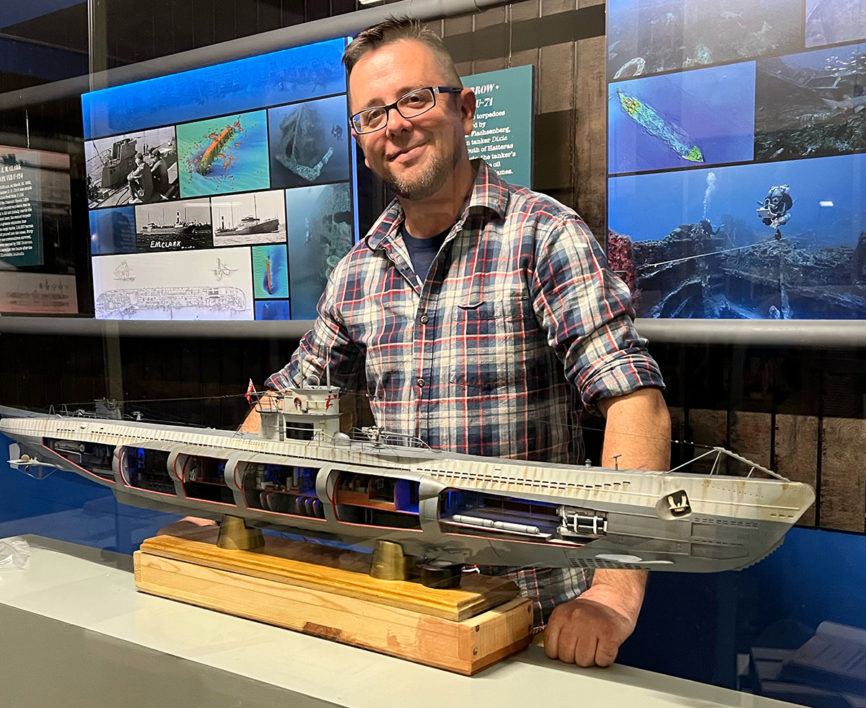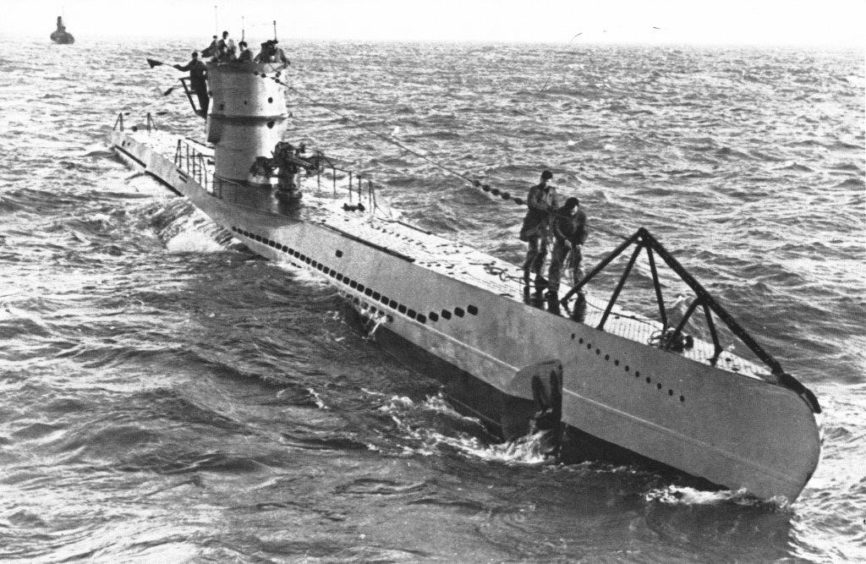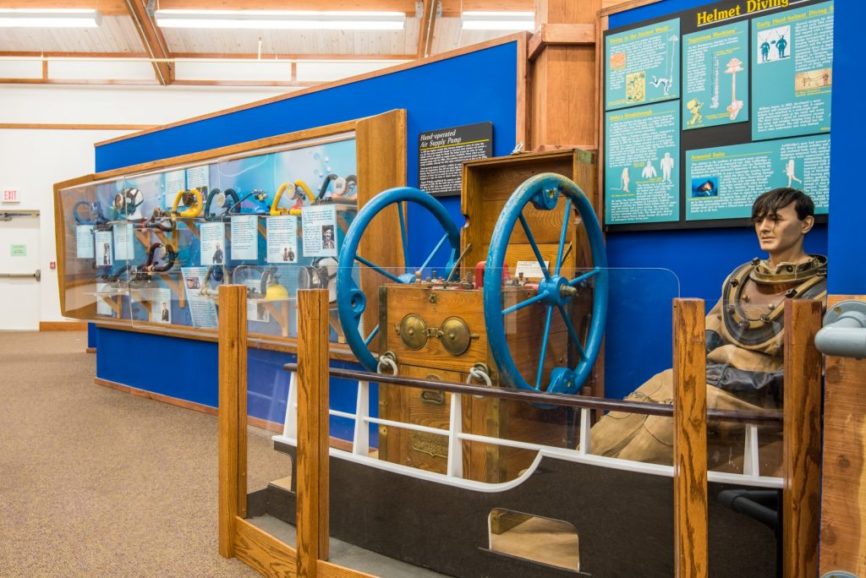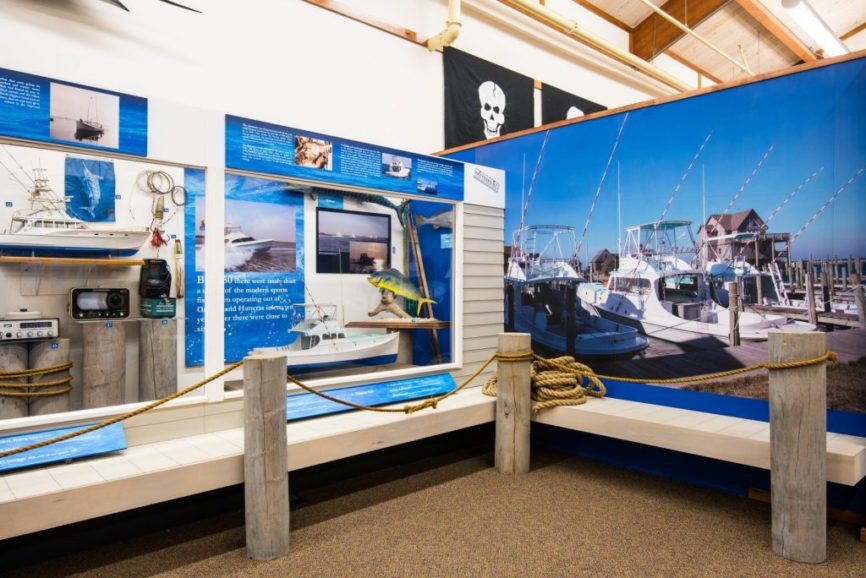The Graveyard of the Atlantic Museum
Located just past the Ocracoke Ferry Terminal, the museum is a must-see part of the Outer Banks experience.

Graveyard of the Atlantic Museum Reopens (2024 update written by Kip Tabb)
After more than a year of renovations and restoration, the Graveyard of the Atlantic Museum in Hatteras Village has reopened.
And it is sensational!
The entrance is dominated by a huge and spectacular rendering of a surfboat filled with a crew from the Lifesaving Service riding a wave as they—apparently—row to the rescue of a ship in distress.

The design of that boat has its own story to tell. It is a Monomoy Boat, named after Monomoy Island off Chatham, Massachusetts. The US Lifesaving Service boat that entered service in the 1890s was standardized to 26 feet in length and seven feet wide. It was manned by a nine-person crew, with eight rowers and a coxswain steering from the stern with a sixteen-foot oar. The boat was double-ended, meaning the bow and stern were identical, minimizing the time needed to reverse direction.
Since the boat is 26 feet long, for obvious reasons, the rendering is not full-sized, but the impact is impressive.

The US Lifesaving Service was the predecessor to the US Coast Guard.
Entering the display area, individual exhibits are highlighted with overhead lighting to make them stand out. At each display are interactive screens that help tell the story of what is behind the glass.
Here, the story of the Outer Banks during the Civil War is brought to life. An often overlooked slice of American history, it was at Ocracoke Island, Hatteras Inlet, and then Roanoke Island that the first Union victories of the Civil War occurred in 1862.

The fear and horror of war came to America’s doorstep in WWI and WWII as German U-boats lurked offshore. That, too, is part of the displays.
Included in that history is a remarkable model of the US Diamond Shoal Lightship, the only lightship ever sunk by an enemy vessel.
Stationed at the treacherous water of Diamond Shoals since 1898, on August 6, 1918, the ship went to the aid of the SS Merak that had been struck by torpedoes fired from U-140. After rescuing the crew, the Diamond Shoal lightship began broadcasting a warning to all Allied ships in the area, warning them of the U-boat danger.

The messages were intercepted by U-140, and the submarine quickly tracked the lightship down. After allowing the ship’s crew and survivors of the Merak to take to lifeboats and row to shore, the Diamond Shoal was sunk with gunfire.
There is also a detailed model of a WWII German U-boat with a cutaway to show what the interior looked like.
However, war is not the only subject in the Graveyard of the Atlantic Museum.
The Outer Banks fishing community is also represented with stories of the early days of commercial and sport fishing. Displays and models tell describe a time when porpoise oil was an important commodity. A model shad boat is on display, as is the Albatros I, which is generally considered the first boat designed specifically for sport fishing. The Albatross fleet still sails from Hatteras Harbor.

The Graveyard of the Atlantic is clearly designed for the entire family. Although the language used to describe various events and displays is somewhat advanced for a five or six year old, it is a visually stunning museum. There are also activities for children included in the displays.
Particularly geared toward kids—but adults also seem drawn to it—is the “Can You Build These Boats” display with various shaped blocks waiting for a would be shipwright.
The museum is not large. It will take an hour, perhaps an hour and a half, to look at everything the museum has to offer, but it will be time very well spent. Located just past the Hatteras Ocracoke Ferry docks, a visit is a perfect destination for a day trip from the northern Outer Banks.
The Graveyard of the Atlantic Museum in Hatteras Village is a small museum. But if the size of the display area is modest, what is packed into it is remarkable. Located just past the Ocracoke Ferry Terminal, the museum is a must-see part of the Outer Banks experience.
A recent addition highlights how important this little museum is in understanding the history of the sea and the Outer Banks.
At the end of June 2022, an intricately detailed model of German U-Boat 522 was given as a gift to the museum by Mike Mills, who built the replica of the submarine.
At first glance, it may not even seem all that remarkable. The model is about 4’ long, maybe a bit longer, and colored the dull gray of the U-Boat fleet. But look more closely, and extraordinary details emerge.

It’s a cutaway of the U-Boat. Looking inside, just how cramped life would be for two or three months at sea becomes clear. Bunks are housed under torpedo tubes, and Mills meticulously placed lights on the inside, illuminating just how closely packed everything was.
In remarks at the model’s unveiling, Mills revealed a bit of misery that his research uncovered that clarifies what life in a U-Boat would have been like.
There were two heads, or bathrooms on the sub, but the need for storage was so great as the U-Boat headed to sea, the forward head was stuffed with supplies and could not be used until the sub was almost back to its port.
The U-522 model is the centerpiece of an expanded WWII exhibit at the Graveyard of the Atlantic Museum. Displayed with the U-522 is the enigma machine, the sophisticated coding device the Nazis used to decode the messages they received from Germany. This is the Enigma machine local diver, and author Jim Bunch found in U-85 in 2011, restored for display.
The display calls attention to the horror of war, a war that came to America’s doorstep as German U-boats stalked their prey off the coast of North Carolina. In the first six months of 1942, Germany almost succeeded in its goal of strangling England as submarines prowled the coast. Between January and June of that year, 78 ships were sunk off the coast of North Carolina, and many more were lost making the horrific journey across the North Atlantic.

The museum, though, includes more than the U-Boat and WWII exhibit. Small as it is, a lot is packed into the display gallery.
There is a compact but fascinating look at the history of undersea exploration. The development of underwater breathing apparatus is traced from the earliest diving suits with an air hose attached to the surface and a diving helmet atop the suit, to modern SCUBA equipment.

One of the museum’s finest displays tells the story of Hatteras sport fishing. In many ways, it is the history of sport fishing in North Carolina and includes information about the activity along the East Coast.
The birth of sport fishing in the state can be traced to Ernal Foster in the 1930s. He was the first local commercial fisherman to realize that he could earn a living taking well-to-do visitors to the Gulf Stream for a day of fishing. He was also the first person locally to have a boat—the Albatross—built specifically for sport fishing.

The museum has put together a fascinating look at those early days of sport fishing, and the exhibit contains intriguing bits of information and facts.
Perhaps one of the most interesting exhibits is about the Civil War and the Outer Banks.
The salvaged remains of the Monitor, the Union’s all-iron ship that sank on December 31, 1862 in a gale, is housed at the Mariners’ Museum in Newport News, Virginia. However, The Graveyard of the Atlantic Museum display does a wonderful job of describing how important to the Civil War and warship design the Monitor’s radical departure from the wooden warships of the day to all iron construction truly was.
Perhaps more importantly, though, the museum explains how significant to the war effort the Outer Banks was. It was at Ocracoke and Hatteras Inlets that the first significant Union victories of the war occurred. And those victories allowed the Union to control the Inner Banks of the state, with northern forces occupying every city from New Bern to Elizabeth City, forcing the Confederacy to keep troops in eastern North Carolina rather than having them available for deployment elsewhere.
The latest news from the museum, which is part of the North Carolina Maritime Museum system, includes a planned expansion. It’s still early in the planning stage, but the state has earmarked $4.2 million to expand Museum’s exhibit space, with an additional $500,000 promised from the Outer Banks Visitors Bureau.





